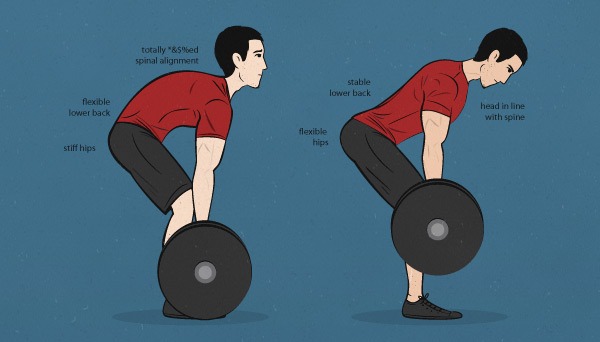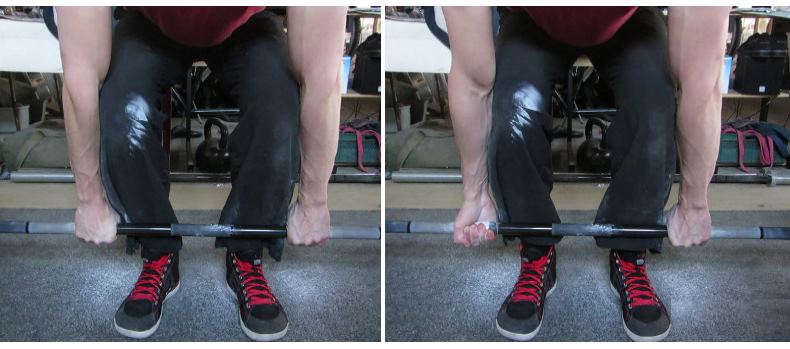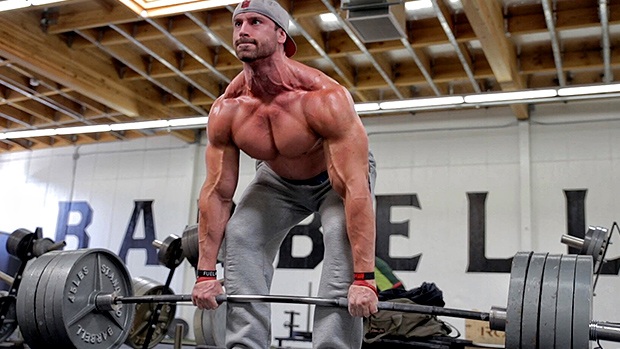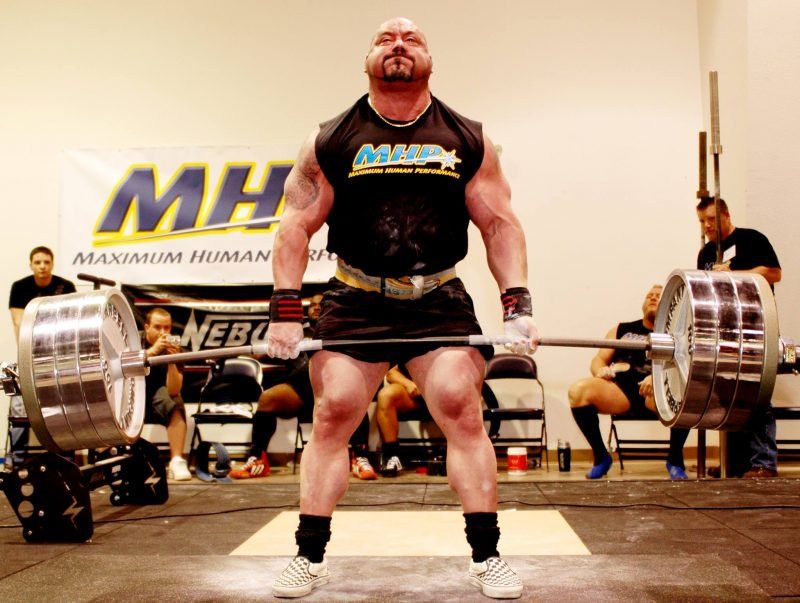I have repeatedly gone on record saying that when it comes to weightlifting, there are only four lift exercises that you absolutely need to do, and this opinion is shared by many other fitness coaches and fitness enthusiasts.
Colloquially being known as the “big four” lifts, I have already discussed two types of presses that will cover almost all of your upper body needs. But the upper body is, of course, only half of the story. To be a truly strong and fit man, you have to work out your lower body as well, in a way that will make your legs, waist, hips, and core both functional and aesthetically pleasing. And, as luck would have it there are only two simple-but-difficult exercises you need!
Why Work Out Legs?
Some people, particularly the novice lifter, might ask why they have to work out their lower body at all. After all, nobody flexes their legs, people only care about the upper body, correct?
I’m not going to go into how effeminate the idea of working out purely to look good is, or how proprioceptive neuromuscular function means that if your legs are strong, it can only make your upper body stronger as well.
Instead, I’m going to point out the obvious: you stand on your legs and you are on your feet for a substantial amount of your day, regardless of whether you are a manual laborer or a cubicle jockey. Almost every motion you do that is remotely athletic is done while standing on your feet: walking, running, kicking, dancing, jumping—it all involves your legs and feet directly. And many more movements, like punching, throwing, and weightlifting, indirectly use the legs. Simply put, if you want to do any of these effectively, you’re gonna have to target them with strength training.
The only two lower body exercises you absolutely need to do are the squat and the deadlift. And while they’re both very useful—I did teach you to squat first, after all—I would recommend the deadlift as the more important of the two, because while the squat will hit every muscle below and including the lower back, the deadlift will hit 90% of those same muscles, and provide a pretty solid exercise for the upper body as well. More specifically, the deadlift will predominantly hit the trapezius muscles and the muscles of the forearm and hands. And you are all quite aware of how much importance I place on strengthening the hands and forearms. All in all, who doesn’t want to work out most of their body with just one exercise?
How To Deadlift
The first thing you absolutely need to learn to do the deadlift is how to “hollow” the back, or as I prefer to call it, “lock” the back. This technique keeps the back tight and straight during the deadlift, which is imperative to do because otherwise you can risk pretty severe back injury.
Stand with your feet shoulder width apart, then exaggeratedly “Stand at attention”—imagine your body lengthening and straightening like a soldier in an old cartoon (laugh if you must, this metaphor helped me visualize the proper position). Feel your chest puff out and your lower back tense. This back tightness is the feeling you want to maintain throughout the deadlift.
Alternatively, you can bend to grasp the bar in your hands and then lock the back. The above is what works for me, but if you want to do it the other way, that’s fine.

Once you have familiarized yourself with that feeling, you can do the deadlift—and for the sake of your back it is imperative you master this body position before you even try to lift. Place the bar on the floor and load it with whatever weights you need. Roll the bar to your shins.
Then lock the back, keep the head and neck tight and looking forward—this helps with proper spinal alignment. While maintaining this locked position, keep your arms straight and begin bending at the knees to the bar. Do what feels natural and bend until your hands can grip the bar. Do not bend at the back or move your shoulders.
From here, you can grasp the bar with both palms facing towards you, or do alternating grips. I find that both palms towards the lifter works the forearms better but again, whatever is comfortable for you.

Now you can begin lifting; maintain the total body tightness and lift with your legs. You should feel as if you are pushing through the floor, which is why I recommend that you do this barefoot if your gym will allow you to do so. Push from the floor and the weight should begin to move. Continue pushing until your legs are straight . The bar should be about at your knees.

Then, clench the buttocks and straighten out at the back and hips, making sure to keep them both tight and straight. The bar should finish at about your hip level.

To release the weight, do not drop the weights like an asshole. Instead, just do a reversal of the lifting motion. Lock the back and bend at the waist until the bar reaches your knees. Then bend at the knees until the bar touches the ground.
Any more advice?
Form is imperative! If you feel any pain in doing this exercise, whether it be in your back or your hips, stop immediately, lower the weight, and work on your form. I give this advice especially for the deadlift, as improper form can lead to slipped discs and broken backs. Bridging can only protect you so much.
And with that, the big four lifts are yours. Enjoy being stronger than most in your gym.
Read More: How To Work Out The Lower Half Of Your Body Using Isometric Exercises
The deadlift is for Kangz (n shiet)
It’s also the king of popping a roid’ and throwing out you’re back permanently. Or shitting your pants violently as you eye the personal trainer using complex trigonometry off the mirrors.
“I’m not staring at you. I looking at the mirror behind you which angles to the mirror to your left which looks at you.”
I do not concur. The squat is much more back-unfriendly than the DL. Biomechanics, fulcrum points, load relative to CG, stretch-contraction reflex will all give you the answer as to why
They are both terrible for your back and knees. Everyone I know who has done these lifts regularly has suffered injuries, some permanently and seriously. There are better ways to get strong.
Such as?
66 and have been doing DLs all my life. Don’t believe I’ll be getting any PRs these days but on DL day, I shoot for volume and still can get a good case of DOMS.
Not only are my knees just fine, thank you very much, but my work requires me to work over a table for hours at a time and while most others my age have given it up, I put in a 12 hour days and my back is also in fine fetters.
I lay my good physical condition to the iron. Those 1 hour sessions pay big dividends as you age.
i have found the most painful part of the deadlift is the first couple inches of the lift from the floor. the rest of the movement isnt to bad. the tendency to want to accelerate the lift by jerking it up, even with good back position form makes it a dangerous lift for the lower back. the hexagonal bar removes the off balance first few inches but makes the gripping all strange while allowing you to lift straight up with your legs instead of forward and up to clear your shins and knees with a straight bar.
Compound weightlifting in general are what matter the most. Anything else is a waste of time.
I work my legs by hiking 10-12 miles at a time up mountains and shit. Works for me.
Not to nit pick too much but don’t suggest a “straight back” while deadlifting. You want the lower spine to still have it’s natural curve at the bottom called lordosis. The picture in the article is a perfect example (the 2nd dude in the pic with 2 computer animated guys) of how your spine should look. Chiropractors and physical therapists always preach “straight back” but if you engage the core too much, you pull your hips into anterior pelvic tilt which actually straightens the spine and leads to bulging and herniated discs. Just a small tip that will save you a lot of pain and money in the long run
Also, deadlifts and squats are not essential to building strong legs. There are other excersises like kettlebell swings, pushing and pulling sleds (if your gym has carpet and actually provides sleds), Bose ball jumps, box jumps, and a lot more that build functional strength in the legs. Deadlifts and squats are great for building power and muscle, but because the excersise takes place in a relatively static position and has a limited range of motion, it doesn’t offer much in terms of athleticism. Kind of like how bench pressing is only useful if a tree falls on you. Squatting and deadlifting will make your legs and body look more imposing, but won’t help you much in a street fight or a race.
I beg to differ that compound lifts have nothing to offer for athleticism. One of the main benchmarks that various national sport leagues use to assess raw strength are the compound lifts- i.e. benchpress, squat, etc. Sure, it won’t make you faster or more agile but when it comes to brute force and strength, being able to benchpress 3 plates will allow an athlete to impose strength where it’s needed.
What’s with the comment section deadlifts are F***ing amazing
If you have to do a lot of sitting at work you’ll begin to notice your posture is better and not to mention your balance as well
Deadlifts are the second best workout you can do and every reader here should at least give it a red hot go before letting the weak thoughts of “oh muh back might get hurt or I might look stupid doing a work out that requires more than the movement of curling my arm”
Tried them. Don’t like them. Don’t do them.
Deadlifts suck when you first start out. Stick with it through the pain and suffering and then you’ll find out what all the hype is about.
Does the barbell moves in a straight line vertically? Is this desirable? If you harden the abdominal area, but relax your ass muscles, then roids are going to be bustin’.
The King of exercise are the gymnast rings. For lifting heavy object off the ground we have machines.
Exactly my tavareesh.
Gymnasts look just as impressive as bodybuilders but with more skills and elegance.
It must suck pumping iron for years to have some guy come along who’s never lifting a dumbbell, same gains as you, but he can do handstands on the rings and one arm pull ups.
Gymnastics is completely impractical for the vast majority of people; especially taller people.
The gymnasts who progress to the most impressive tricks are most likely genetic freaks anyway. If they concentrated on weights, they would be much bigger but they cannot afford to do that in their sport.
Genetic freaks?
Discipline, dedication and determination are seen as something weird now?
Hm.
Top gymnasts are manlets though. Everyone has different levers and is built for different activities. There is no end all be all for working out. Stop being so absolute.
Here’s my fitness e-book:
Squats, Deadlifts, Military Press, Bench Press
Steak, Sweet Potatoes, Butter, Spinach
Only $9.99 on Amazon, get it before it’s gone.
But who was protein?
I’m not even going to read this. The king of lifts is the squat.
For those of you that are complaining about how Squats & Deadlifts wreck your back or knees remember, if you’re not going to be a competitive power lifter you can adjust the exercises for your own personal body needs. If you can’t Squat below parallel do box Squats and adjust the box to a height that works for you. Same with Deadlifts. There’s no excuse to completely give up the lifts.
This commenting app sucks. I hope Roosh is still looking for a replacement.
I’ like to put this exercise on my list but I can’t.
I suffered from inguinal hernias that meant surgery on both sides.
It’s supposed to be OK after all those years, but even today, some exercises bring pain on those spots, and I definitely want to avoid another medical procedure, so…
I’ve one degenerated disc and two herniated discs. I’m a bodybuilder and have made my best gains since I started getting very specific about lifting, by which I refer to the following things:
-always keep a neutral back (for health, not gains)
-do lots of different exercises (one exercise won’t hit all muscle heads very well)
-no swinging
-microloading (0,5 pounds at a time)
-train each muscle individually if you can (multiple calf exercises for example)
With my history of injuries I will never do barbell bent over rows, back squats or deadlifts again; the risks are horrifying and I would not have my injuries if I had not believed the hype in my 20’s; fuck the “big three”. There’s no reason why you need to do any specific competition lift or make it more dangerous for yourself; for example doing standing barbell bent over rows instead of lying down on a bench and doing them. The only difference between these two is that the latter removes the wholly unnecessary strain on the spine.
If you want big spinal erectors, do back extensions on a support bench with weights; zero risk, plenty of gains. There’s plenty of machines for your quads and hamstrings and glute ham raises are tough and safe. Also remember that deads and squats do jack for your calves. Sure a barrel shaped powerlifter will have better calves than your average joe but still vastly inferior to the calves of an intelligent bodybuilder. I also train my inner thighs and smaller glute muscles separately for definition.
I understand the point of this article for guys who just want “overall” size and a decent manly body but if you must do deadlifts, heed with caution and perhaps never lift off the floor at all. Rack deads are significantly safer.
The deadlift is the king of ruining your back.
I trained at a powerlifting gym, and the amount of guys who screwed up their backs with deadlifts is hard to ignore.
I did olympic weightlifting during my formative years with no problems or injuries. So my advice is if you can’t clean it, then don’t bother deadlifting it.
Those guys who got the back problems were the ones really pushing it. Those slow, contorted lifts were painful just to watch. Sometimes one would spasm towards the end of the lift.
All that pain and damage just for the sake of some boring up/down movement.
Take up Thai boxing or BJJ instead.
“Take up Thai boxing or BJJ instead.”
That’s fine if you don’t want to gain serious muscle. There’s a reasonable middle ground between maxing out in the powerlifts and not lifting at all. It is kind of ironic that the people pushing “functional” “bang for your buck” lifting are actually the ones who are encouraging people to wreck their backs; if you want minimalistic tight schedule lifting, then do dips, glute ham raises and hack squats with some lat pulldowns and seated rows instead. You can pass on the rows if your schedule is super tight.
A broken back is not very functional and olympic lifting is not the safest thing either; those jerky movements are severe on the joints.
There’s two kinds of tough lifting; the one that gains you injuries but is simple and quick and the one that’s relatively safe but most gym guys don’t want to do it because it takes a lot of time and commitment if you want to fill up all the weak spots left by powerlifting.
Deadlifting is for butt building. If you’re gay or female that works great. Real men do curls(and benchpressing).
Building your glutes helps with:
Low back injury prevention
Faster running
Harder striking (since force comes from hips not just shoulders)
Harder and deeper pelvic thrusting during sex
If you look womanly because you built your glutes then you just have no sexual dimorphism and your hips are probably wider than your shoulders. I built my glutes and nobody thinks I look like a woman. A man’s physique and bone structure is such that developed glutes won’t give you a bubble butt (well that’s if you had enough prenatal testosterone in the womb at least)
Naja, jedem das seine alter!